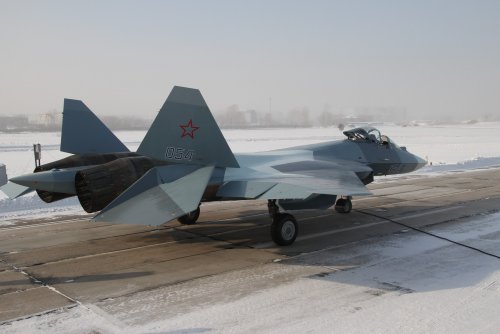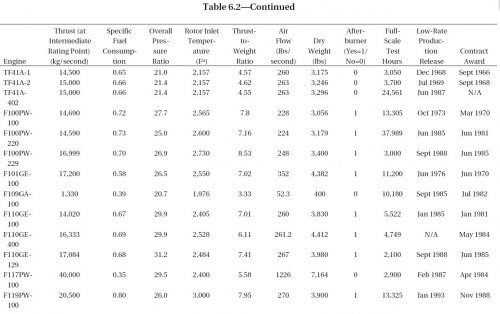chuck4 said:
PaulMM (Overscan) said:
Have a good source that says ~308lb/sec mass flow for the F135, which has same core but a larger fan (0.51 versus 0.3 bypass ratio) than the F119 and should therefore have a higher mass flow rate. Assuming say 280lb/sec for F119 gives 33,700lb in this theoretical calculation. Thats about as meaningful as your figure.
Did your source say anything about what the actual thrust from the F135 was when it was pushing through 308 lbs/sec? If so, it would be a useful plot point to develop some sort of massflow to thrust diagram, either a line plot, or surface plot. If it needs to be a surface plot, then look for what the appropriate 3rd dimension would be for the plot.
To me it seem a more fruitful to use a discussion to develop a vbroader and insightful picture into how things work, even if in the process one might make a few mistaken extrapolations, then to let the discussion degenerate into sterile bickering over a few data points.
From a post over on F-16.net of the meat of the Jane's article:
"The JSF-F119 was the engine of the X-35 concept demonstrators, and because of the short time-scale it was in turn a direct derivative of the F-22's F119 engine.
In contrast, the F135 is optimised for the propulsion of the F-35, though it is likewise derived from the F119, and is thus a two-shaft low-BPR turbofan with an augmentor. On the basis of information released by 2005 the only significant difference between the two engines is that the F135 has a two-stage LP turbine (that of the F119 having a single stage). Whereas the F119 is loosely described as being "in the 35,000 lb (155.75 kN) class", and the JSF-F119 as being rated in the 170 kN (38,200 lb) class, the F135 is described as "in the 40,000 lb (178 kN) class." Indeed, it is likely that the F135 will eventually be developed to give power well beyond the figures given in the data below.
Apart from the broad outline given in the description below, because of its high security classification, little is publicly known of the actual hardware of the F135, apart from the overall opinion that, as the crucial blading is all fractionally larger, because of the greater mass flows, the engine should be exceptionally tough and durable. Pratt & Whitney has, however, been permitted to disclose some of the radical advances that this engine will introduce in the fields of self-diagnostics and health monitoring. Among technological "firsts" claimed for the basic F135 are on-wing (this simply means "with the engine installed in the aircraft") trim balancing, elimination of the need to rig the installation on replacing an engine, and the elimination of
safety wire (previously used to ensure security of such items as nuts and bolts).
Ground-breaking PHM health-monitoring and self-diagnostics systems. The intention is that PHM, a new acronym which will become important (meaning Prognostics and Health-Monitoring), will automatically take account of any in-flight fault, or incipient fault, adjust engine operation and inform the pilot, and in real time transfer data to the aircraft's home base. Thus, any replacement components will be ready for retrofit as the aircraft lands, with the engine pronounced fit again (the plan is) in about 15 minutes, which is said to be a 94 per cent improvement over present times. Of course, that is based on the replacement of externals, not such items as turbine blades.
Externals, in fact, differ markedly from those of the F119 used in the twin-engined F/A-22, though accessories are grouped on the underside as in the ancestor engine. The F135 is expected to set a new low need for special maintenance tools, and to have every external item immediately available upon opening the large access doors with stealth-type zig-zag edges. Indeed, Pratt & Whitney says "all critical features" will be at once accessible. Objectives include a reduction in operating cost -- presumably compared with such engines as the F100-PW-229, for example -- of 50 per cent, and an extension in time between scheduled maintenance of 225 per cent (one F135 document even claims "Scheduled maintenance requirement eliminated"). To this end, PHM will make use of electrostatic and other sensors to monitor such parameters as debris generation, vibration, blade health and lubricating-oil quality. The suite of sensors will constantly monitor approximately 500 data streams, which will be integrated with the F-35's own systems. The complete PHM system has been developed in partnership with NASA Ames, which created vital data-fusion algorithms, NASA Dryden and NASA Glenn, with flight development to be carried out with a C-17. As noted previously, the aim is to predict the need for inspection or parts-replacement, so that, via a satellite link, the airbase or aircraft carrier knows the engine health before the aircraft returns from its mission.
Apart from the challenging 94 per cent improvement in fault-rectification time, other design objectives include a 35 per cent reduction in cost of ownership, compared to legacy systems, a reduction in fault-detection time despite a 50 per cent reduction in the number of maintenance technicians, three times the hot-section reliability, and a 225 per cent increase in time between shop visits.
Back in 1997 the JSF programme had firmed up into three major aircraft versions, conventional (CTOL), STOVL and carrier (CV). Today these are designated as:
F-35A Engine: F135-PW-100. This is the baseline version of the F135.
F-35B Engine: F135-PW-600. This engine differs from other versions in incorporating a vectoring nozzle, bleed-air ports for roll posts for lateral control at low airspeeds, and a forward drive shaft to the LiftFan to provide lift independently of the wings. The basic engine is identical to other versions.
F-35C Engine: F135-PW-400. This is almost identical to the F135-PW-100, apart from small changes in accessories, and elimination of materials not resistant to salty environments.
The following refers principally to the SDD engines:
Type: Two-shaft augmented turbofan, the F135-PW-600 version having additional STOVL features.
Intake: The intake hub is the same in all versions, being unaffected by connection of the LiftFan drive shaft.
Fan: Three integrally bladed rotors, derived from F119 but with new features giving greater mass flow with higher pressure ratio, improved stability, maximum resistance to bird and other impact damage, and minimum signature. Significantly lighter and less costly than predecessors, yet provides most of the thrust. The casing is the first to be made for the US military from organic-matrix composite (OMC) material. First-stage vanes (stators) hollow OMC, rotors 2 and 3 flank-milled titanium alloy. Split casing permitting reblading or minor repairs, and weld repairs are (mid-2004) being developed for all stages. Inside the nosecone a single bolt permits removal of the fan module in 40 minutes. This bolt is replaced in the Dash-600 engine by a connector to the LiftFan drive shaft. Inlet diameter 1,168 mm (46.0 in). Bypass ratio, (F135-PW-100, -400) 0.57; (F135-PW-600), conventional flight 0.56, powered lift 0.514.
HP Compressor: Six-stage SDD compressor derived from F119, rotating in opposition to LP spool. Split forward case in titanium alloy housing two stages of asymmetric variable-incidence guide vanes (stators). Cast nickel-alloy rear stators grouped in segments in titanium-alloy ring casing of high creep strength. All stators integrally bladed, either flat-milled like the fan or high-speed milled. All six rotors integrally bladed, first two in damage-tolerant titanium alloy, the remainder high-strength nickel alloy. Crucial No 3 bearing is a simple squirrel-cage unit, lighter and easier to install than the corresponding bearing in the F119 (which comprises a ring and 24 rods). The production bearing may be made of corrosion-resistant silicon nitride hybrid ceramic.
Mass flow (F135-100) 139.6 kg (307.8 lb)/s. OPR (F135-PW-100, -400) 35, (F135-PW-600) conventional flight 34, powered lift 29.
Combustion Chamber: Short annular diffuser/combustor, derived from F119. Outer casing including HPT nozzle ring (lighter and less costly than in previous P&W fighter engines), handling airflow at 4,150 kPa (600 lb/sq in) at 649°C (1,200°F), and containing air-conditioning connections and inspection ports. Liner with impingement and film cooling containing Floatwall ceramic-coated nickel-based cast segments, each containing "thousands of holes", which "float" from their anchored location. Intense combustion with fuel/air ratio 20 per cent higher than in F100 engine to give near-record gas temperature exceeding 2,200°C (4,000°F).
HP Turbine: High-work single stage based on F119, with advanced airfoil coating and cooling derived from F119, but with cooling airflow doubled. Impingement cooling augmented by closing down rear stator angles. Nozzle ring organic-matrix vanes. The rotor comprises a main disk, miniature disk and cover plates, all incorporating the same high-strength powder-metallurgy (sintered) high-rotor blades of second-generation single-crystal Ni-based alloy, with advanced outer air seals. The HPT rotates at speeds exceeding 15,000 rpm, generating 47,725 kW (64,000 shp) from gas at just over 1,649°C (3,000°F), cooled by air supplied at 538°C (1,000°F) from the HPC. To minimise pressure loss the
rotor blades are cooled by Tangential On-Board Injection (TOBI), each blade being a complex casting with multiple cooling passages. Growth in blade-tip diameter is controlled by a unique slow-responding thermally isolated support ring in materials selected for their low thermal expansion, giving passive clearance control through the normal engine-operating range.
LP Turbine: Two-stage design giving significantly greater shaft power than the single-stage LPT of the F119. Rotates in opposition to the HP turbine. Typical of the simplified design of the F135 are the main shaft bearings, (see note under HP compressor), and it is possible that the full production F135 may have a corrosion-resistant ceramic (silicon nitride) bearing. In the F135-PW-600 the LPT torque is transmitted through the fan and a dry-plate clutch to the LiftFan drive shaft, the turbine power being shared by the two driven items. Casing fabricated in refractory nickel and Pratt & Whitney proprietary materials. Supports aft-bearing compartment, whilst diffusing and turning the 1,093°C (2,000°F) efflux with minimum pressure loss (see next).
Afterburner: Large-volume with advanced flame-holder system. Fully variable convergent/divergent nozzle, with 15 hydraulically driven hinged flaps, controlling propulsive jet at 621 kPa (90 lb/sq in) at up to 1,927°C (3,500°F). Unique pressure-balance system to assist the hydraulic actuators which vary area and profile, and also to assist bypass air to reduce area when maximum loads are encountered. In the F135-PW-600 the complete nozzle can vector through 95° in 2.5 seconds to give 80.34 kN (18,000 lb st) lift force for STOVL. The Dash-100 and -400 LO axi-symmetric nozzle; The Dash-600 3BSM (three-bearing swivel module) has shorter variable flaps. It was designed to be able to bolt directly on to the STOVL version of the rival F136-GE-600 engine.
Accessories: Accessory gearbox driven off main HP shaft. Integrated Power Package (IPP) comprises the engine-start system and the F-35's
Auxiliary Power Unit (APU). Dual fixed-displacement vane-type
fuel pumps (the gear-type originally used added too much heat), with servo valves. Fuel/oil heat exchanger. Advanced prognostic and on-condition health-management systems. Commercially developed fire containment system."


